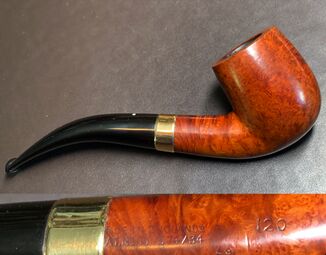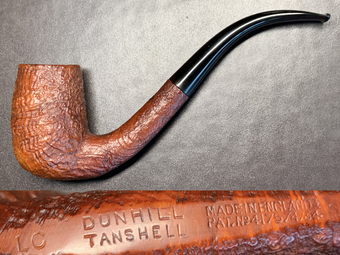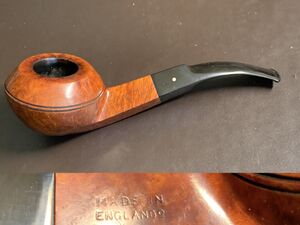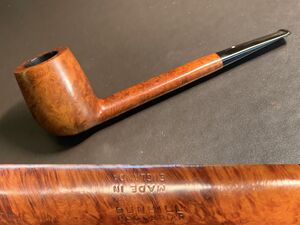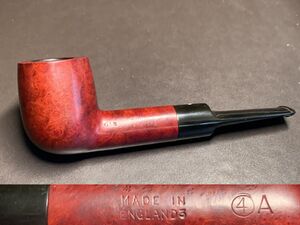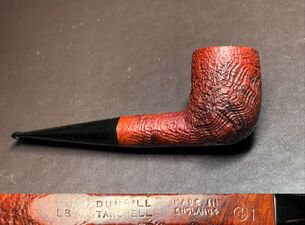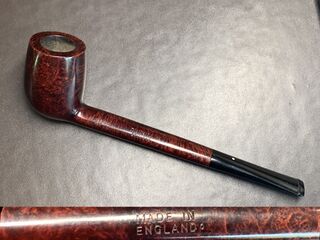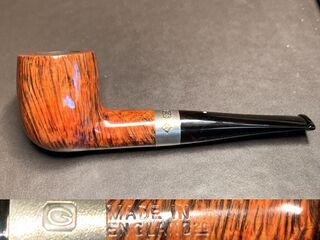Erik Hesse
Perhaps the greatest Dunhill's collection after Loring's.
I was born in Berkeley, California in 1954, and for the first 30 or so years of my life, it was still “normal” to see men smoking their pipes publically. My next-door neighbor in the North Berkeley hills was a professor at U. C. Berkeley and a Chaucer scholar. I remember as a boy seeing this dapper man descend his stairs in the morning to go to work. Almost always he sported an elegant Harris tweed and puffed happily away on one of what l later learned was his regular rotation of Charatan pipes.
My best friend’s father was also a pipe smoker and I suspect that my interest in the pipe began with my observations of these two men. (...) See more about Dr. Hesse here.
![]() In closing, I want to emphasize that to my taste the finest of the Dunhill pipes are as fine as any pipes ever made. This does not mean that I do not believe that there are other (e.g., English, Italian, Scandinavian and American) pipe makers who have produced equally outstanding products.
In closing, I want to emphasize that to my taste the finest of the Dunhill pipes are as fine as any pipes ever made. This does not mean that I do not believe that there are other (e.g., English, Italian, Scandinavian and American) pipe makers who have produced equally outstanding products.![]() Hesse.
Hesse.
* From the personal collection of Yang Forcióri. It is rare to find a cased set with more than two pipes. Additionally, most of the sets with three or more pipes that I have seen consist of only smaller pipes. This set is remarkable not only in terms of its condition, but as well, the pipes are good sized, with the 60 being a true group 4. Note also, as per the inscription in the second photo, the three pipes are “made from one briar root”.
** This pipe is extraordinarily large -- 11 inches in length and 4 ¾ inches in height. It is un-smoked and remains in its almost flawless original case. I assume this pipe was made to be a display piece for a Dunhill shop, although the patent number is for American export, which makes it impossible to speculate as to what shop that might have been. The pipe includes the original inner tube that also has correct patent stamping.
*** Bowl height is almost 2.5 inches.
**** These pipes are the only two LO9’s that I have ever seen. I have not been able to find any other individual who has ever seen one. Finally, to my best knowledge, the L09 is not listed in any Dunhill catalogue. The pipe is essentially an outsized 120.
***** From the personal collection of John_C._Loring.
* This pipe is LB size and sports 2 red bakelite factory mouthpieces.
** From the personal collection of John_C._Loring.
*** From the personal collection of Edsel James.
* The SP stands for a pipe that was not in stock but was ordered by the purchaser at a given shop. It does not stand for “Special Pipe” or “Special Order” as is often thought
** From the personal collection of Les Sechler.
*** From the personal collection of David Gabriel.
**** From the personal collection of Edsel James. This was Edsel James’ “go to” pipe for more than 40 years. It has a gold repair band and the nomenclature is too buffed to read the end of the patent number or the date stamp. See below where this pipe is pictured along with a picture from P&T of Edsel holding the pipe not long before he sold it to me.
* From the personal collection of Edsel James.
** From the personal collection of John_C._Loring.
* Loring states on pp. 53 “in the ‘60’s and ‘70’s the 843 was sometimes stamped 835, the two pipes being identical except for the bit.”
Addendum:
Edsel James was my first real “pipe mentor” and over the years, although we never actually met in person, he also became a good friend.
In early 1999, I came across an article in Pipes and Tobaccos magazine (Winter, 1998) entitled “Mr. Dunhill” (see above) which was penned by Chuck Stanion. Among other things, the article included a photograph of three old deeply blasted Dunhill “Shell” pipes: They were just what I had been looking for without success. Since at that time I was not yet “connected” to many people in the pipe world it seemed like Edsel James might hold the key to my accessing one or two of these beautiful old pipes. (This was in the “old days” when rare pipes usually changed hands via personal connections. Although the modern auctioning approach to trading has created access to a much wider range of pipes, I lament the days where trading was undertaken mostly in the way it did between Edsel and me. I have a strong distaste for the “modern” auction format) (...) See the full story here.
Edsel’s oldest son, Craig, wrote a brief sketch of his father’s life at my request when I told him about the project I was working on for Pipedia. With his permission I close with an attachment of Craig’s letter. See it here.
- I certainly do not consider all of the pipes in my collection extraordinary. Many, for whatever reason, simply have something about them that I just “take to”.
- For more on Edsel James see it here.






![BRUYERE Set, "INNER TUBE" PAT. NO 5861/12 5. Shapes 60, 35 & 42 [Reg. N. 654638 on stems] (1925)*](/images/thumb/0/02/DunhillSetA.jpg/290px-DunhillSetA.jpg)





























